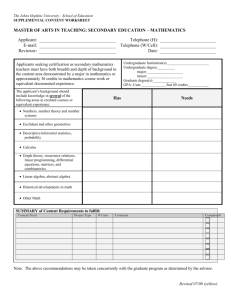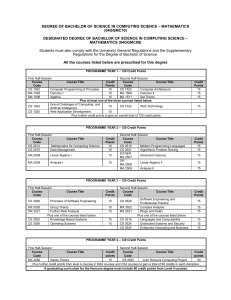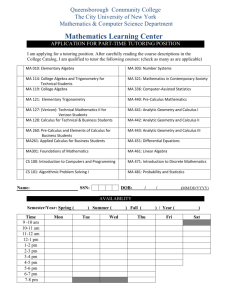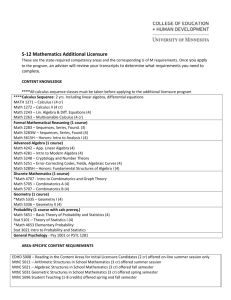Comprehensive Review - Bakersfield College
advertisement
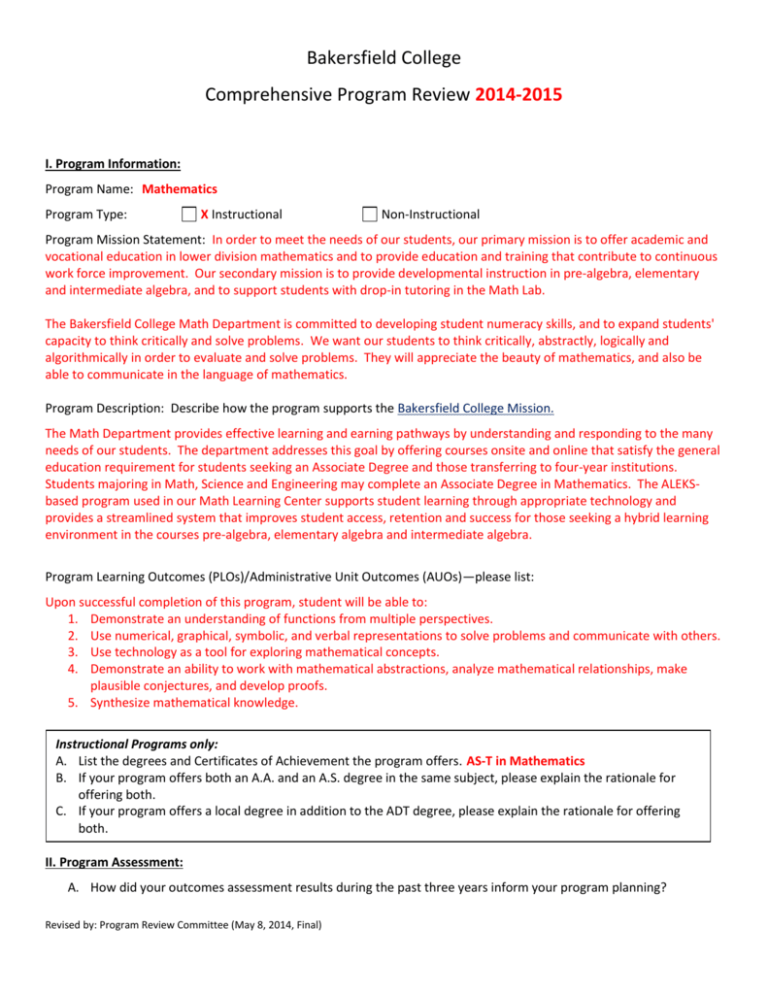
Bakersfield College Comprehensive Program Review 2014-2015 I. Program Information: Program Name: Mathematics Program Type: X Instructional Non-Instructional Program Mission Statement: In order to meet the needs of our students, our primary mission is to offer academic and vocational education in lower division mathematics and to provide education and training that contribute to continuous work force improvement. Our secondary mission is to provide developmental instruction in pre-algebra, elementary and intermediate algebra, and to support students with drop-in tutoring in the Math Lab. The Bakersfield College Math Department is committed to developing student numeracy skills, and to expand students' capacity to think critically and solve problems. We want our students to think critically, abstractly, logically and algorithmically in order to evaluate and solve problems. They will appreciate the beauty of mathematics, and also be able to communicate in the language of mathematics. Program Description: Describe how the program supports the Bakersfield College Mission. The Math Department provides effective learning and earning pathways by understanding and responding to the many needs of our students. The department addresses this goal by offering courses onsite and online that satisfy the general education requirement for students seeking an Associate Degree and those transferring to four-year institutions. Students majoring in Math, Science and Engineering may complete an Associate Degree in Mathematics. The ALEKSbased program used in our Math Learning Center supports student learning through appropriate technology and provides a streamlined system that improves student access, retention and success for those seeking a hybrid learning environment in the courses pre-algebra, elementary algebra and intermediate algebra. Program Learning Outcomes (PLOs)/Administrative Unit Outcomes (AUOs)—please list: Upon successful completion of this program, student will be able to: 1. Demonstrate an understanding of functions from multiple perspectives. 2. Use numerical, graphical, symbolic, and verbal representations to solve problems and communicate with others. 3. Use technology as a tool for exploring mathematical concepts. 4. Demonstrate an ability to work with mathematical abstractions, analyze mathematical relationships, make plausible conjectures, and develop proofs. 5. Synthesize mathematical knowledge. Instructional Programs only: A. List the degrees and Certificates of Achievement the program offers. AS-T in Mathematics B. If your program offers both an A.A. and an A.S. degree in the same subject, please explain the rationale for offering both. C. If your program offers a local degree in addition to the ADT degree, please explain the rationale for offering both. II. Program Assessment: A. How did your outcomes assessment results during the past three years inform your program planning? Revised by: Program Review Committee (May 8, 2014, Final) We continue to try new things to improve success rates for the algebra sequence. Beginning in Spring and Summer 2013, we started offering a new math sequence of Math 60 and 70 for Elementary and Intermediate Algebra, replacing Math A and D. We are continuing to evaluate the learning outcomes and success rates of each course, and we will review content based on data as it is collected. Starting in Spring 2014 we offered two “compressed and stacked” options for Math 60 and 70 students. While selfpaced hybrid students have always had the option to complete more than one course in a semester; these new compressed 60/70 courses offer the option in a face-to-face environment. Several faculty were sent to a Statway conference in Summer 2014 to explore its effectiveness for our department. We have established a Streamlined Math Pathway Committee to further study another algebra course option for students planning to take statistics. We continue to coordinate scheduling of the calculus sequence with science and engineering faculty. We have added an additional section of Calculus III to better meet demand. B. How did your outcomes assessment results during the past three years inform your resource requests this year? Our students’ success in achieving their learning outcomes is due in part to our class sizes of 30-40 students. Currently we are not able to offer enough sections of this size to meet demand. In order to maintain these medium class size offerings across pre-collegiate, general education, and STEM major classes, we are requesting two replacement faculty positions and one new faculty in Delano. Engineering program development in Delano will require increased offerings of the pre-calculus and calculus sequence. Success rates in the self-paced hybrid courses increased when we required students to come in regularly to test. We are requesting more hours for the teaching assistant and teacher aide positions in order to increase student contacts and redesign self-paced course structure. C. Describe how the program monitors and evaluates its effectiveness. We review success and retention rates in face-to-face and online delivery methods. Math faculty regularly attend conferences to learn about successful programs across the country. We assess student learning outcomes annually in each course. Course-specific faculty groups meet as needs arise to make adjustments in textbooks, supporting software, or curriculum. D. Describe how the program engages all unit members in the self-evaluation dialogue and process. We hold monthly department meetings to discuss concerns as they arise. Adjunct faculty are invited to all department meetings. Committees and small groups are formed for further discussion as needed. The Department Chair breaks up sections of program review and chooses individual faculty or pairs to work on specific sections ensuring that our reviews are a collaborative effort. Course learning outcomes are assessed annually by all faculty teaching the course, directed by specific faculty course leads and correlated by an assessment lead. The Department Chair and Math Lab Coordinator meet regularly to discuss self-paced hybrid course issues. E. Provide recent data on the measurement of the PLOs/AUOs, as well as a brief summary of findings. The Math Program is an Associate in Science in Math for Transfer AS Degree. The courses are the 18-unit calculus sequence, Math 6abcde. Calculus faculty evaluated one program level outcome in Spring 2012, another in Fall 2012, and a third in Fall 2013. Results for Fall 2013 are typical: 83 students were tested with embedded questions in an exam and 54 demonstrated they had successfully learned to use technology as a tool for exploring mathematical concepts. Thus 65% of the students demonstrated competency. Revised by: Program Review Committee (May 8, 2014, Final) F. What have the program’s PLOs/ AUOs revealed or confirmed in the last three years? Individual results in course-level and program level tend to indicate that 50% or more of students are achieving the learning outcome as measured by embedded questions on exams. G. If applicable, list other information, data feedback or metrics to assess the program’s effectiveness (e.g., surveys, job placement, transfer rates, output measurements). STEM students participated in a focus group in Spring of 2014. Most of them shared that getting into a math class was a huge barrier in completing their SEP in a timely manner. Many of the required pre-calculus and calculus courses had full waitlists. H. Discuss the strengths of your program. We have 9 high tech classrooms that facilitate student engagement. In an effort to enhance multiple measure placements, a flow chart of math course offerings was developed for students and counselors which describe the progression of math courses and prerequisites. Our math faculty seek out new teaching techniques and new technology that will improve student success. We have been open to exploring and trying new ideas such as flipped classrooms, compressed classes, and streamlining math pathways for students while ensuring that the rigor of instruction and student learning remains intact. I. Discuss areas for improvement in your program. The SLO's for some of our courses need to be reviewed and revised. We need to make sure that the Course Description in the catalogue agrees with what we have on the Course Outline of Record in Curricunet as well. In spite of have such a hug number of course offerings and sections, we do a pretty good job of collecting SLO data. We could improve getting all that data uploaded to Curricunet. J. If applicable, describe any unplanned events that impacted your program. The Math Department was surprised by the number of sections of ACDV B72 (an accelerated course for arithmetic and pre-algebra) that were offered in Fall 2014. Based on information we had received from our previous Department Chair, the department expected the data on the success rates of the ACDV students in the pilot classes to be evaluated before the course was put through Curriculum Committee as a new course offering. The data was never seen from the pilot, and the course was put through Curriculum Committee without the Math Department approving it as a prerequisite for Math B60 (Beginning Algebra). The Math Department is now gathering more information on this issue, and hope to resolve this matter in such a way as to maintain the integrity of our math program, and yet accommodate the students currently enrolled who expect to get into Math B60 after successfully completing ACDV B72. In our Math B22 (statistics) and Math B2 (business calculus) the units were dropped from 5 units to 4 units starting Summer 2014 against the advice of math faculty. Students in these classes now only meet with their instructors 4 hours per week as opposed to 5 hours per week. The challenge has been to maintain the rigor and student success rates while still covering roughly the same amount of material. This change is relatively new, so it is yet to be seen how the reduction in contact hours with the students will affect their success rates. III. Resource Analysis: A. Human Resources 1. If you are requesting any additional positions, explain briefly how the additional positions will contribute to increased student success. (Faculty Request form; Classified Request form) Revised by: Program Review Committee (May 8, 2014, Final) We are requesting 2 faculty replacements for the BC main campus, and one new faculty for Delano. In addition, we are requesting more hours/months for existing classified staff in the Math Lab. (see attached request forms) 2. Professional Development (Professional Development form) a. Describe briefly the effectiveness of the professional development your program has been engaged with (either providing or attending) during the last cycle, focusing on how it contributed to student success. Professors in our department have attended and participated in numerous professional development events over the past 3 years that are geared to contributing to student success. For example, Habits of Mind workshops gave professors the tools needed to help students gain the skills and attitude needed to be successful in college and in life. Our faculty MIH mentors gave students a support system and guidance in school. When our faculty members attended ATD, AMATYC, MAA, CMC3, North Kern Math conferences/meetings, they were given the opportunity to network with faculty at other schools and shared best practices and lessons learned in teaching which directly translates to better teaching practices that benefit our BC students. In attending the accelerated workshop on how to teach compressed and accelerated classes at BC and by visiting the schools in Tennessee and New York, faculty were able to witness alternate teaching methods in other math programs which directly helped our faculty look for ways to help students get through math faster, offer alternate pathways yet still learn the required material. By taking ASL classes, ASL/Math workshops, and visiting schools with a focus towards ASL students, our faculty were learning ways to connect better with deaf students. CID training helped our faculty ensure that our math courses transfer seamlessly to CSUs. The Raising Calculus to the Surface workshop gave teachers the tools to use technology to help calculus students visualize math in 3D. BrightLink and Moodle workshops trained our faculty in using technology to better disseminate information to students as well as gave us alternative options for assessing student learning. And, lastly, faculty took classes for themselves through online MOOC courses which allowed not only for their own intellectual growth but to learn about current trends in mathematics which they will pass on to their students as inspiration for their future career prospects. b. Provide rationale for future professional development opportunities and contributions that your program can make. In the future, math faculty will continue to participate in conferences, courses, and training in order to learn new teaching techniques and technology, broaden their own subject matter expertise, and will continue to visit other schools to get ideas for streamlining math pathways (get students through math faster while still maintaining rigor). Another goal is to initiate Math Seminars with guest speakers, similar to the speakers who have already inspired many STEM students during their luncheon colloquia, to emphasize the special field of mathematics. B. Facilities (M&O requests can be submitted by completing the M&O Request form.) 1. Assess the effectiveness of the facilities used by your program in meeting college strategic goals. We hold a majority of our classes in the Math Science Building. There is handicap access to classrooms on the second floor via an elevator on the north side of the building which is old and could use some refurbishing. To get to the south side classrooms upstairs, handicap students must go through a hallway with two doors. It appears that handicap access to these doors was being installed, but for some reason the work was interrupted. The doors have a handicap button, but it does not work to open either door. This may be a violation of American Disability Act. 2. Justify your facilities and M & O request. C. Technology (Technology requests can be made by filling out the ISIT Request form.) 1. Has your program received new or repurposed technology in this 3-year cycle? Yes. Revised by: Program Review Committee (May 8, 2014, Final) a. If yes, discuss the assessment of its effectiveness as it relates to student, program, or administrative outcomes. We have the software that comes with the Britelinks installed in MS 104, MS 105, MS 106, MS 108, MS 109, MS 110, and MS 111. The faculty have determined the software to be limited, and are researching to utilize different software. In a couple of the Britelink rooms, we have currently installed Smartware. b. If no, what technology could play a contributing factor in future student success and outcomes for your program? How would you evaluate the effectiveness of this technology? 2. Discuss the effectiveness of technology used in your area to meet college strategic goals. Instructors are currently utilizing technology. Parts of the lecture notes are being prepared with the current software in order to be more effective in the class. Some instructors have used technology to help with statistics, numerical methods such as Euler’s , etc. 3. Does your program need new or repurposed technology to support student success? Justify your ISIT Technology Request and your vision for meeting student, program, or administrative unit outcomes for this next 3-year cycle. The Math department needs the technology and software to stay current with the world and to be more effective in the classroom. D. Budget (Changes to the budget allocation can be requested using the Budget Change Request Form). If you are requesting any additional funding, explain briefly how it will contribute to increased student success. IV. Trend Data Analysis: Review the data provided by Institutional Research. Provide an analysis of program data throughout the last three years, including: A. Changes in student demographics (gender, age and ethnicity). In the past five years, the age group, 19 and below, has decreased by 7% from 41% to 34% and the age group, 20 to 29, has increased by 8% from 44% to 52%. All other age groups remained stable. There are more Hispanic students in math now and has increased by 7% in the last three years from 59% to 66%. White students have decreased by 4% during the same time period from 26% to 22%. The age population of students taking math courses are younger (under age 30) than the age population of Bakersfield College students. The ethnic makeup of math students is comparable to the student population at Bakersfield College. B. Changes in enrollment (headcount, sections, course enrollment, and productivity). Census day enrollment had increased by close to 2000 students during the past three years. This is due to more sections being offered in the last two years. Also, the unduplicated head count has risen by 1,000 students during that same time period. Productivity has increased from 21 to 21.7 during the past three years. Classes not only fill, but waitlist are filled to their maximum and students are turned away from traditional instruction. For the 2013 – 2014 academic year, the number of students on the waitlist at the census date 2,367. With the current trend, more faculty members need to be hired to accommodate student demand. Revised by: Program Review Committee (May 8, 2014, Final) C. Success and retention for face-to-face as well as online/distance courses. The success rate for all math courses for the 2013 – 2014 was 53%, which a 7% increase from the 2010 – 2011 year. The traditional course success rate was 56% as compare to the distance education rate which was 41%. Both these rate have increased during the same period. Traditional increased by 6% and distance education increased by 13%. Changes in procedure in the Math Lab/Hybrid Course for non-transfer level course could be attributed to the increase in success for distance education. Similar increases occurred for retention rates in all math courses over last four years. D. Degrees and certificates awarded (three-year trend data for each degree and/or certificate awarded). The requirements for an Associate in Science in Mathematics have not changed. The number of degree completions is at a five year high. Many of our engineering students complete the qualification for an Associate degree in Math, but never apply. Perhaps by encouraging the engineering students to apply for an Associate degree in Math, we can increase the number of degrees awarded in our program. E. Other program-specific data (please specify or attach). The Math department has rewritten its curriculum for Elementary and Intermediate Algebra. Math BA (Elementary Algebra) is now Math B60 and Math BD (Intermediate Algebra) is now Math 70. The success rate in Math B60 for the past year is at 50.9%, which includes traditional and distance education (hybrid) classes. This is an increase compared to Math BA where it was very rare to achieve a success of rate of 50%. Math B70 had a success rate of 49%. This is comparable to pass success rates in Math BD in the past. F. List degrees and certificates awarded (three-year trend data for each degree and certificate awarded). Include targets (goal numbers) for the next three years. Degree or Certificate Associate of Arts in Mathematics 20112012 4 20122013 3 *Associate of Science for Transfer in Mathematics 2013- 2014- 2015- 20162014 2015 2016 2017 9 X X X 10 11 12 *Note that starting May 2015, we will only be offering the AS-T Degree in Math V. Progress on Previously Established Program Goals, Future Goals and Action Plans: A. List the program’s goals from the previous Program Review. For each goal, please discuss progress and changes. If the program is addressing more than two (2) goals, please duplicate this section. Previously Established Goal (state goal) 1. Modernize classrooms with Smartboard or Britelink projectors Which institutional goals from the Bakersfield College Strategic Plan will be advanced upon completion of this goal? (select all that apply) X 1: Student Success 2: Communication 3: Facilities & Infrastructure Revised by: Program Review Committee (May 8, 2014, Final) Progress on goal achievement (Choose one) XCompleted: Fall 2013 (Date) Comments (if applicable) 9 of our 11 math classrooms are updated with technology. We still 4: Oversight & Accountability 5: Integration 6: Professional Development X1: Student Success 2: Communication 3: Facilities & Infrastructure 4: Oversight & Accountability 5: Integration 6: Professional Development 2. Examine other institution's remedial programs. Revised: ___________ (Date) (state revised goal) Completed: ________ (Date) X Revised: ___________ (Date) See Future Goal 2 below. need to update MS 103 and LA 116. We went to several other schools to get ideas and have incorporated some of them in the Math Lab. We are just now trying the Flipped Classroom idea in Math B22 and hope to expand it to several other courses. This is an ongoing process of trial and error to find a good fit for our BC students. B. List the program’s goals for the next three years. Ensure that stated goals are specific and measurable. State how each program goal supports the College’s strategic goals. Each program goal must include an action plan. Future Goal 1. Develop Electronic Course Portfolios Action Plan Lead person for this goal Kurt Klopstein Timeline for Completion: Start Fall 2014 and have it Find a platform that will completed by Fall 2015. allow faculty to share course material. Have faculty submit sample syllabi, exams, quizzes, labs, etc. Assign someone to maintain and update the portfolios. Which institutional goals from the Bakersfield College Strategic Plan will be advanced upon completion of this goal? (select all that apply) X1: Student Success X2: Communication 3: Facilities & Infrastructure 4: Oversight & Accountability Future Goal 2. Look for solutions to the remediation problem, and to also streamline math pathways for students. 5: Integration Action Plan Set up a committee to examine, discuss, and recommend new course ideas to the math department. Visit other colleges, or go to conferences to learn what they are doing. Refine our compressed and hybrid classes to be more effective. Perhaps design our own algebra course for statistics. Revised by: Program Review Committee (May 8, 2014, Final) X6: Professional Development Lead person for this goal Kris Toler Timeline for Completion: We have already begun taking action on this goal. This will be an ongoing process, so no completion date will be given. Which institutional goals from the Bakersfield College Strategic Plan will be advanced upon completion of this goal? (select all that apply) X1: Student Success 2: Communication 3: Facilities & Infrastructure 4: Oversight & Accountability 5: Integration X6: Professional Development VI. Curricular Revisions (Instructional Programs only): A. Review of Course Information: o Column A list all of the courses associated with the degree. o Column B list the Fall term the review process will be started for ongoing compliance. o Column C list the compliance due date. o Column D list any changes to courses with regard to distance education. o Column E list corresponding C-ID descriptors if available. http://www.c-id.net/ **Dates listed should reflect a five year cycle allowing for one year of review to maintain ongoing compliance.** A. Course B. Fall Term Review will be Submitted Math B50 Math B60 Math B70 Math B1a Math B1b Math B2 Math B4a Math B6a Math B6b Math B6c Math B6d Math B6e Math B21 Math B22 Math B23 2014 2016 2016 2017 2017 2017 2017 2017 2017 2017 2017 2017 2014 2019 2018 C. D. Distance Compliance Education Due Date Changes 2/1/2013 1/1/2017 1/1/2017 5/1/2018 4/1/2018 12/1/2018 12/1/2018 11/1/2018 10/1/2018 11/1/2018 11/1/2018 11/1/2018 2/1/2014 2/1/2020 2/1/2019 None None None None None None None None None None None None None None None E. C-ID Descriptors Available Math 140 Math 120 Math 211 Math 221 Math 230 Math 240 Math 250 Math 110 Math 130 A. Review of Program Information: Is the program information housed in CurricUNET accurate? (Considerations: changes in course(s) names and/or suffixes as well as additions/deletions of courses). If not, then a program modification needs to be started in CurricUNET to reflect the necessary changes. Explain the requested changes below. Yes. Revised by: Program Review Committee (May 8, 2014, Final) Is the program and course listing information in the current catalog accurate? If not, list the requested changes below. Catalog information should reflect what is in CurricUNET. No. The program listing needs to be updated to reflect the newly approved AS-T. B. Student Education Plan (SEP) Pathway(s) uploaded to “Attached Files” in CurricUNET. If applicable, SEP Pathway with CSU Breadth indicated? Yes or No If applicable, SEP Pathway with IGETC indicated? Yes or No If applicable, SEP Pathway with BC General Education indicated? Yes or No **Please ensure that the information housed in CurricUNET and the current catalog match. ** C. If applicable, provide a description of the program’s future adoption of C-ID descriptors and Associate Degree for Transfer (ADT) or Model Curricula. The ADT for Math has been approved. All math courses that have corresponding C-ID descriptors are either “In Progress” or” Conditionally Approved.” VII. Faculty and Staff Engagement: A. Discuss how program members have engaged in institutional efforts such as committees, presentations, and departmental activities. Our department is committed to being a presence on campus and in the community. Math faculty members are involved in the decision making process on campus by participating in committees such as the Trembley Award Committee, Commencement Committee, Curriculum Committee, Graduation Committee, Assessment Committee, Student Success Committee, Levan Award Committee, STEM, MESA Board of Directors, High School Outreach, Common Assessment, Achieve the Dream Data Coaches, Habits of Mind, and the Accreditation Committee. Faculty members have also given presentations to their peers on campus and to members of the community. One member of our faculty received the Levan Faculty Summer Grant and presented his research on “My Journey Through Deaf Education”. Several of our faculty members served as judges for the MAA (Mathematical Association of America ) Southern California-Nevada Section Student Poster Completion, and the BMC AP Calculus Contest. We have math faculty who were leading members of the Habits of Mind Team and have presented their data and research each semester for school -wide professional development. To maintain and foster relationships with K-12 mathematics instructors in Kern County, our department organizes and participates in several annual events: Math Articulation Day, High School Outreach Visitations, and the North Kern Math Summit. Our department utilizes activities outside of the school environment to promote relationships with each other. For example, at the end of each semester, our department throws a party for all faculty and family. Every Finals Week, math faculty gets together at a local restaurant to have a departmental breakfast. Every August, members of our department are invited to attend a Math Faculty Retreat in Las Vegas. Revised by: Program Review Committee (May 8, 2014, Final) B. Instruction Only: Discuss how adjunct faculty are included in departmental training, discussions and decisionmaking. At the beginning of the fall semester, our department chair attends the adjunct orientation to help assist adjuncts with the nuances of working at Bakersfield College. Adjuncts are included on the department’s e-mail listserv so they receive all the department communication. Full-time instructors are assigned to adjunct as faculty mentors if needed. Adjuncts are also invited to attend monthly department meetings where they can be included in discussions regarding any decision making process. If adjuncts cannot attend the meetings, due to other employment obligations, they are sent the notes from our department meeting via e-mail so they can keep abreast of the math department's issues and activities. VIII. Program Funding Sources: Identify any non-KCCD general fund sources Title of Account/Grant/Categorical Funding Start Date End Date Percentage of Program Budget Covered Positions funded wholly or in part Foundation Accounts Grants Categorical Funding IX. Conclusions and Findings: Present any conclusions and findings about the program. The Math Department supports BC students in the classroom as well as outside of the classroom. The Math Learning Center staff offers drop-in tutoring for developmental math students. Math faculty members support several clubs on campus such as the Future Teacher Club, the Math Club, and the Women in Engineering and Science Club. Other faculty members devote time to and support student achievement in activities like the MAA Student Poster Project, AMAYTIC Student Mathematics League Competition, and the local Bakersfield Math Council AP Calculus Competition. Some math faculty serve as mentors in the new campus-wide Making It Happen Initiative, and others are using more supplemental instruction. The department further supports student learning through the use of appropriate technology. We now have 9 of our 11 math classrooms outfitted with new technology. Our statistics courses use the TI-83/84 graphing calculators as an integral part of learning about and exploring data. We support the statistics students with a self-sustaining Calculator Rental Program which rents graphing calculators to the students on the main campus and at Delano for the reasonable price of $10 per semester to ensure that this technology is made available to statistics students who might not be able to afford a calculator. The members of our department are committed to professional growth and serve on many key committees. We have participated in many school-wide initiatives such Habits of Mind, the Big Tent project, and Multiple Measures and Common Assessment Initiatives. Our efforts show our commitment not only to BC students, but to BC as an institution. We also support the current Completion Agenda, but based on the Trend Data, we are not offering enough sections of math to meet the demands of the students. The week before a semester starts, we find that the waitlist for almost every section of math is full. Students are turned away. This is true for our developmental courses as well as for our transfer level courses. Our priority classrooms are utilized to the point that we must seek out classrooms in other areas Revised by: Program Review Committee (May 8, 2014, Final) of campus. Just hiring replacement math faculty is not enough. To support student success and completion, we need to hire more math faculty and we need more classroom space. VII. Attachments (place a checkmark beside the forms listed below that are attached): X Faculty Request Form Professional Development X Classified Request Form ISIT Form X Best Practices Form (Required) Revised by: Program Review Committee (May 8, 2014, Final) Budget Change Request Form M & O Form Other: ____________________


